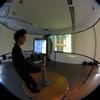 |
PlaceWorld is the result of collaboration between artists, social and
computer scientists undertaken as part of the eSCAPE Project (ESPRIT
25377, 1997-2000), the aim of which was to inform the development of
future large scale shared and social virtual environments. Realized as
a distributed multi-user VE capable of running over wide-area
networks, PlaceWorld has three goals: first, to act as a coherent
metaphor for browsing and experiencing disparate electronic art
installations and virtual artefacts; second to be an evolving social
environment in its own right; and third to provide a persistent
software architecture in which non-trivial virtual artefacts may be
dynamically created and integrated.
|
Landscape
Borrowing from previous multimedia installations "Place - a user's
manual" and "The Virtual Museum", PlaceWorld combines a familiar
planar city-like layout with unusual virtual content.


The various features and artifacts of PlaceWorld are described below.
Avatars and paths
The PlaceWorld environment gradually evolves a structure based on
its usage by its inhabitants. Artefacts and areas of interest
slowly become larger, drawing attention to their popularity.
Users each leave behind glowing translucent trails as they pass
through the environment:






 video (537k)
video (537k)
These trials can be utilised by other inhabitants to chart the
movement of companions.
The trials also contribute automatically to the network of pathways
that connect areas in the worlds. User trails following similar routes
reinforce one another to become concrete 'highways' allowing rapid
transport from region to region, whilst trails leading to unpopular
areas of the world fade over time.


 video (537k)
video (537k)
A user's personal trial can be used as a transport mechanism allowing
multiple users to gather and interact through a text-based chat
facility. Users can talk to one another privately or broadcast their
words for all to see.
 video (308k)
video (308k)
Cylinders
Located in PlaceWorld are a number of Cylindrical 'buildings' which
act as portals leading to more extensive electronic art works.
These four works (shown below) were pre-existing stand alone
single-user applications that had been developed independently on
different projects:
AIG Lab



 video (479k)
video (479k)
Oil
Rig



 video (425k)
video (425k)



 video (844k)
video (844k)Memory Theatre VR



 video (518k)
video (518k)
The data structures and rendering techniques required to efficiently
store and display each of these work are radically different. The
AIG's Maverik system was used to unite these disparate
works. Maverik employs a callback mechanism to encapsulate the data
structures and rendering techniques specific to each work. This common
interface to the works allows them to coexist within a single virtual
environment.
The Deva system, also developed within the group, provided the distribution layer on top of Maverik that
was used to implement PlaceWorld. Deva utilizes a client-server
architecture with a customisable high-level language to describe
schemes for synchronization. Furthermore, customisable smoothing
techniques are employed to reduce the effect of network lag.
Customizations
Users are encouraged to personalize and contribute to the
environment.
Generators in the world create new objects:




These objects can be personalized:



 video (707k)
video (707k)







Objects can be moved around the environment to mark
territory. Advanced users can create new art pieces.
Links, visualized as pathways in the sky, can be created by users
allowing fast transportation to favourite areas.



 video (692k)
video (692k)
In-use
The PlaceWorld architecture, contents, and a purpose built walk-in
panoramic navigation display device with cylindrical projection screen
and touch sensitive display were publicly exhibited at the ESPRIT
i3NET conference in Jonkoping, Sweden, and at The Doors of Perception
conference, Amsterdam, both in Q4 2000.



